These extremely bizarre mushrooms may have you thinking you’ve stumbled across an extraterrestrial lifeform! Stalked puffballs (Calostoma) are a super fun, somewhat gross, foraging find. They’re not that common, so finding one is really a treat. Stalked puffballs aren’t edible, not that you’d want to try eating it anyway.
In North America, there are four known stalked puffball mushroom species. They are quite unique looking, even from each other, so it’s pretty easy to tell them apart. Stalked puffballs are a prime example of something being beautiful while also looking absolutely disgusting. A wonderful polarity, we think!
- Scientific Name: Calostoma species
- Common Names: Stalked puffballs
- Habitat: Nutrient rich soil
- Edibility: Inedible
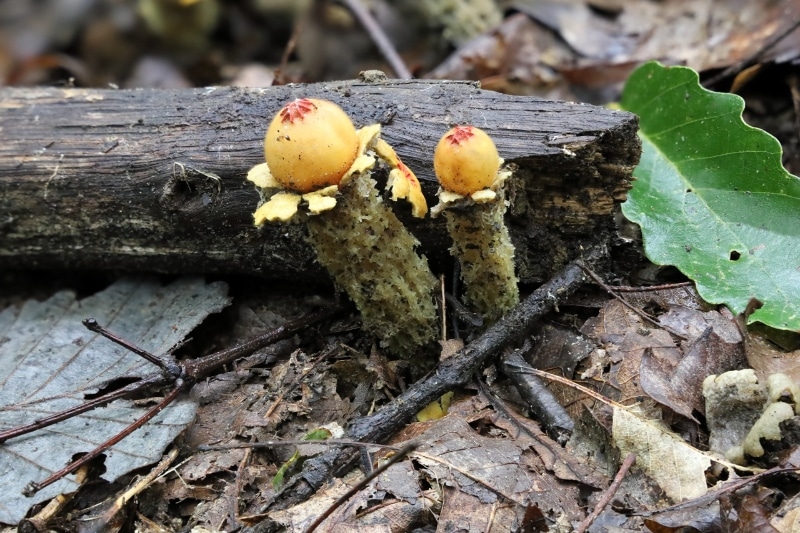
Calostoma lutescens by Chris Parrish on Mushroom Observer
Jump to:
All About Stalked Puffballs
Stalked puffballs are distinctive for their spherical head that sits atop a gelatinous stalk. The mushrooms start out as small, round, egg-like-looking balls under the soil surface. This egg-shaped head holds and protects the spores as the mushroom begins development. It’s rare to see them at this point because they’re in the soil or just slightly above the soil line. The round ball is the spore case of the mushroom, and when it matures fully, spores will be released from the center.

Calostoma lutescens by Jessica Justice on Mushroom Observer
As the mushroom grows, it develops a stalk and sheds its outer layer. This is when you’ll see them on the forest floor – they literally rise up from the soil. The protective outer layer often melts or breaks into pieces and lands on the ground around the stalk.
The stem is made up of interwoven stalks and resembles a tall pedestal for the weird jelly ball spore case that sits perched on top. At maturity, the ball opens up a small slit to release its pores, which are inside it. The opening looks like a pair of pursed lips and is how the genus earned the common name “hot lips.” It’s really quite disconcerting to stumble upon.
Calostoma species are mycorrhizal, which means they grow in association with specific tree species. The tree type varies by mushroom species. Stalked puffballs always grow from the ground. They do not grow on wood or from trees.

Calostoma by Penny Firth on Mushroom Observer
Stalked puffballs belong to the genus Calostoma. DNA analysis now shows that Calostoma species belong to the Boletales order. When they were first discovered, it was thought they were related to true puffballs, but that isn’t the case. These fungi split from their relatives between 52 and 115 million years ago and developed their distinctive appearance through rapid changes.
Calostoma species share more similarities with boletes than with true puffballs or earthstars. They do not look anything like the classic bolete, though! It’s wild that they are related in any way at all and is a great demonstration of the complicated ingenuity of nature. Their family ties connect them to Scleroderma and Pisolithus species.
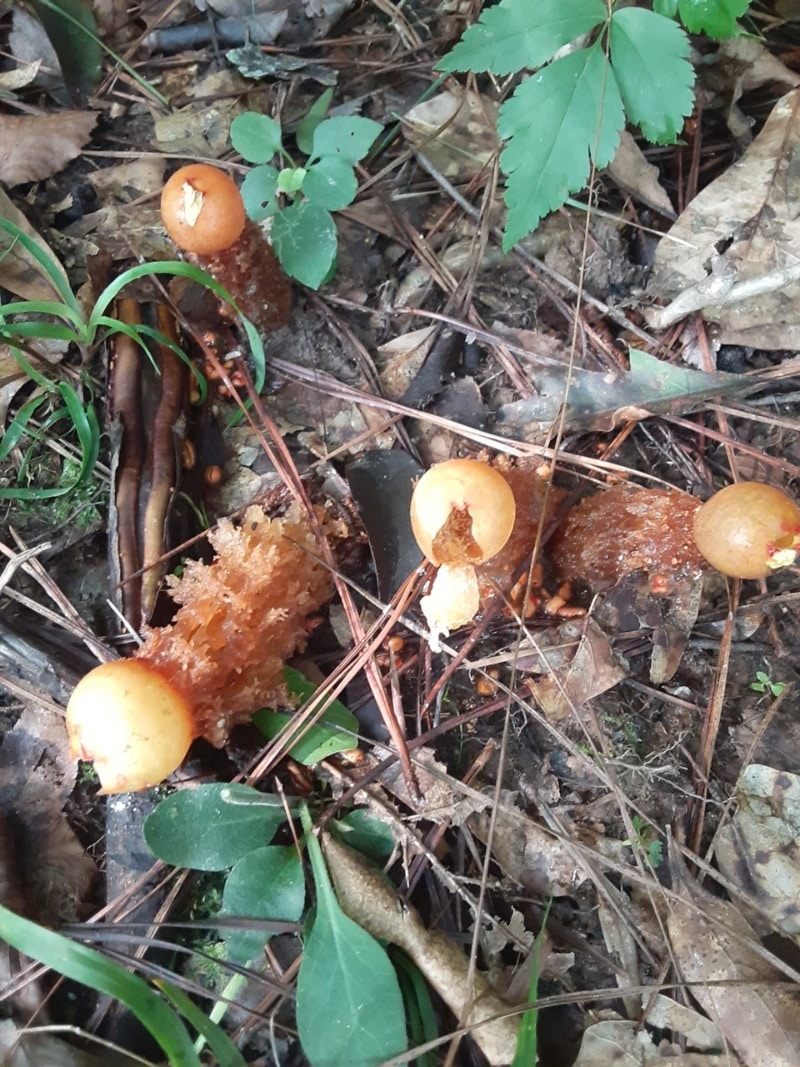
Calostoma lutescens by Unknown Subject on Mushroom Observer
Key characteristics of stalked puffballs:
- A round spore case measuring about 0.8 inches in diameter (this is the ball on the top of the stalk)
- A thick, gelatinous stalk ranging from 0.6 to 1.6 inches tall.
- A stalk(stem) composed of several interwoven or braided strands that give it a ridged or reticulated appearance.
- Brightly colored openings (ostioles) at the top of the ball that look like tiny lips
- A unique outer layer that peels away as the fungus matures
- Growth from the ground (never on trees or logs)

Calostoma cinnabarinum by Calvin H Coffin on Mushroom Observer
North American Stalked Puffballs
North America has four distinct species of stalked puffballs. Each species has unique characteristics that make identification straightforward.
Red Slimy-Stalked Puffball (Calostoma cinnabarinum)
The red slimy-stalked puffball is the most distinctive member of the stalked puffballs. Nature gave this fungus a bright red, spherical head (about 0.8 inches wide) perched on a reddish-orange stalk (0.6 to 1.6 inches tall). The stalked puffball starts out as a small round egg-like looking ball tucked under the soil surface and covered in clear jelly. The jelly protects the fungus as it begins development.

Calostoma cinnabarinum by Scott Johnson on Mushroom Observer
The thick, whitish-yellowish gelatinous coating covers the entire thing when it is young. As the mushroom grows, it develops a stalk that lifts it out of the ground. The development of the stalk pushes the spore case through the slimy coating. The now unneeded gelatinous coating then drips down the stem like aspic jelly.
When the jelly is gone, the cap is bright red and powdery. The powder wears off with age, and the color changes to orangish or yellowish.


Calostoma cinnabarinum by Michelle on Mushroom Observer
Around the bottom of the round ball spore case are 4-5 bright red rays or ridges called peristomes. They look a bit like they were stitched on. The stem is made up of several gelatinous strands that interweave to create a stalk. These strands vary from red to yellowish-brown and give the stem a reticulated pattern. But this is just the strands (or cords) wound up tightly together. The stem looks spongy because of the gelatinous strands – it is not the “normal” solid or dense stem you usually see on mushrooms.
From above, the mushroom looks like a cherry tomato that splatted out some of its inner seeds and flesh. Pieces of the bright red cap membrane break off as the mushroom ages, leaving red pieces on the ground around the fungus. These pieces fall into the yellowish jelly that dripped down the cap earlier. The red cap pieces surrounded by yellow jelly look remarkably like the innards of a tomato. The jelly will dry up with time, and wind or small animals may carry the reddish pieces away.

Calostoma cinnabarinum by Dave W on Mushroom Observer

Calostoma cinnabarinum by Crystal on Mushroom Observer
This ectomycorrhizal fungus forms mutualistic relationships with oak trees. It thrives in humid, moist environments, particularly in the eastern United States. Its range extends from Massachusetts south to Florida and as far west as Texas. The species is most abundant in the Appalachian Mountains, especially at higher elevations. The red slimy-stalked puffball also fruits in Central and South America, including Mexico, Belize, Guatemala, Panama, Colombia, and Brazil. Interestingly, disjunct populations have also been recorded in East Asia, with sightings in seven provinces of mainland China, Taiwan, Indonesia, Japan, and South Korea.
The red slimy-stalked puffball prefers wetter forests and is typically found in damp woods or humid conditions. It fruits most commonly in late summer and fall, although it may also occur in spring. This mushroom may fruit alone but is more often in scattered groupings, sometimes densely so.
Other common names include Stalked puffball in aspic and Gelatinous stalked puffball.

Calostoma cinnabarinum by Giff Beaton on Mushroom Observer
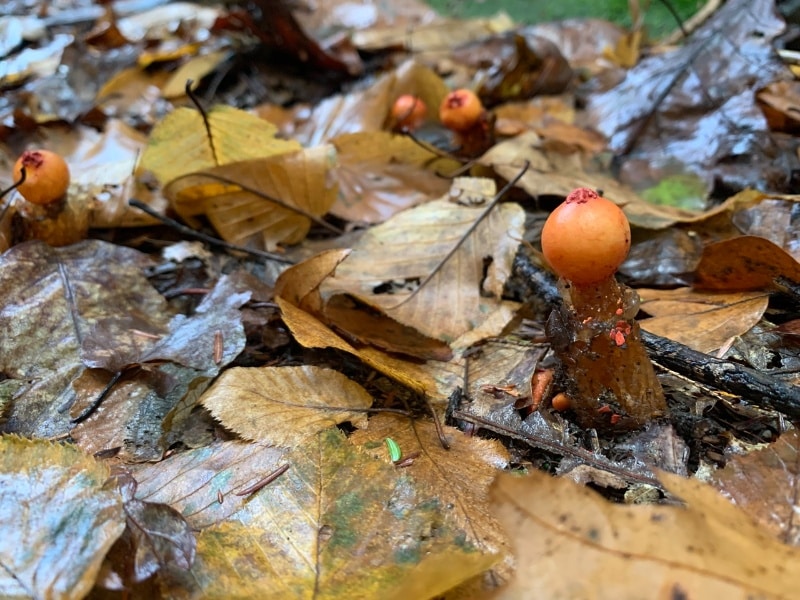
Calostoma cinnabarinum by David A. Riggs on Mushroom Observer
Collared Calostoma (Calostoma lutescens)
The collared calostoma has a yellow globe spore sac with distinctive red, puckered lips. Like the other stalked puffballs, it starts out as a round ball beneath the soil surface. This species reaches 1.6 to 2 inches tall.
The spore case is generally orange to orange-yellowish and smooth. It has no decorations and isn’t covered in jelly-like the red slimy-stalked puffball. However, it is covered by a yellowish outer later, much like a partial veil. When the spore sac grows, it breaks through this veil. This leaves a unique torn collar beneath its spore case, which is where the common name comes from.

Calostoma lutescens by r.shrubber on Mushroom Observer
The spore sac develops a beak in the center for spore dispersal. This beak is very bright crimson red. It is ridged and looks quite like a rooster’s comb protruding from the spore case.
The stem is made up of several yellow strands. These weave together to create a stalk structure, and the overall look is of pale, intertwined pasta strands. With age, the stalk darkens to dirty yellow or brownish. A side view of this mushroom species is quite bizarre. It looks like a smooth yellow ball nestled in a pedestal of thin yellow pasta.
The collared calostoma appears in fall or winter in eastern North America, from Massachusetts down to Arkansas. However, it is most common in the Appalachians because it prefers the damp, mossy environment. This stalked puffball grows mycorhizzaly with oak trees. Collared calostomas grow from the ground and may appear alone or in scattered or dense groupings.
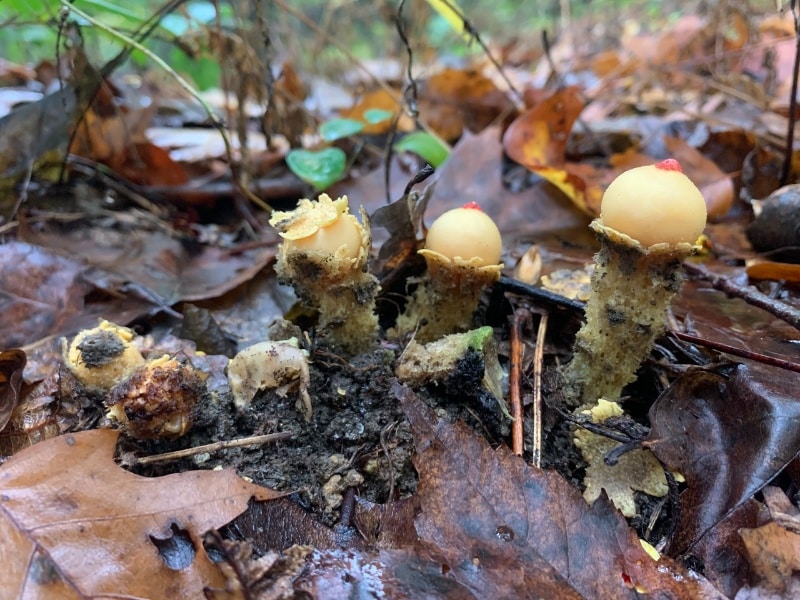
Calostoma lutescens by David A. Riggs on Mushroom Observer

Calostoma lutescens by Larry Lynch on Mushroom Observer
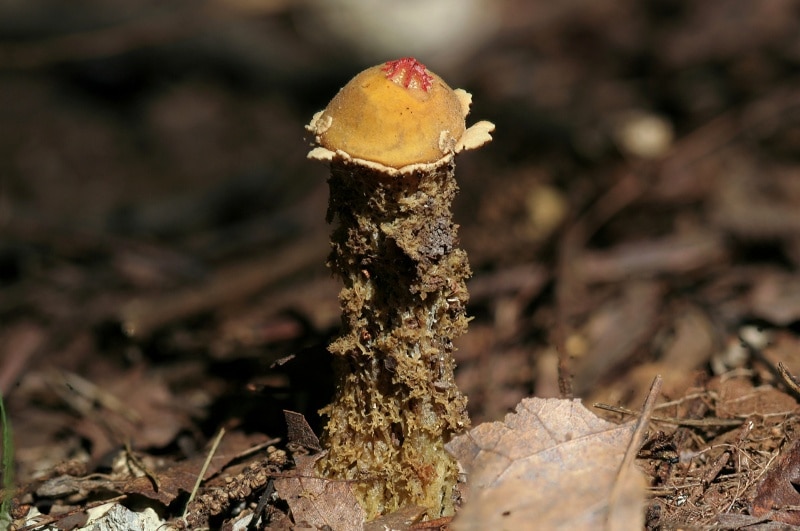
Calostoma lutescens by Jacob Kalichman on Mushroom Observer
Calostoma ravenelii
This species is a smaller stalked puffball. Its spore case ranges from 0.3 to 0.6 inches wide, and the stem is .25-1 inch tall. It is differentiated from other species by its lack of jelly around the spore case and lack of a felt-like collar beneath the spore case.

Calostoma ravenelii by Philly4071 on Mushroom Observer
C. ravenelii, like all the stalked puffballs, starts out as a round ball just below the soil surface. When young, the spore case is covered with a coating like a partial veil. The coating veil is whitish and has a felt-like feel. As it grows, the white coating breaks apart and leaves patches on the spore case. It also sheds them on the ground. Underneath the white patches, the surface of the spore case is dry, smooth, and dull yellow.
As the spore case matures, it develops a bright crimson red ridged beak, very similar to the collared stalked puffball. The red beak resembles two heavily red lipsticked lips or a rooster’s comb standing on the spore case. It is extremely noticeable and distinctive.
The stem of C.ravenelii is made up of several pale brownish strands. These strands are gelatinous and interwoven to create a sturdy structure for the spore case.
This species is quite similar to the collared stalked puffball, except it lacks the collar. It is the same yellowish color with bright red ridged “lips” on the spore case for spore dispersal. It occurs with various hardwood trees in the eastern and southeastern United States. It grows from the ground and may fruit alone, but more often, it appears in scattered or dense groupings.

Calostoma ravenelii by Jacob Kalichman on Mushroom Observer

Calostoma ravenelii by walt sturgeon on Mushroom Observer
Calostoma microsporum
C. microsporum is the rarest of the four stalked puffball species in North America. It shares many traits with C. ravenelii but has yellowish ridges around its crimson-red beak-like opening.

Calostoma microsporum by Ryan on Mushroom Observer
Like the other stalked puffballs, it starts out as a spore case under the soil surface. The rounded spore case is covered by a white felt-like casing, like a partial veil. As the mushroom grows, the spore case breaks through the casing. The broken casing leaves whitish granules and patches behind on the spore case. The spore case surface underneath the patches is smooth, dry, and dull yellow.
A ridged beak develops from the center of the spore case. The ridges of the beak are actually yellowish, while the inner surfaces are red. When the mushroom is very young, the beak may be all yellow before it develops its red coloring. The yellow makes the overall appearance of the beak less brilliant than C. ravenelii and the collared calostoma.
The stem of C.microsporum is light brown and made up of several gelatinous strands. The strands are interwoven or braided and create a strong structure for the spore case to sit on. The stem looks a lot like a sculpted pile of angel hair pasta or like the wax dripping down a tall candle. It is uneven, ridged, and squishy.
The stem reaches 1.6 to 2.4 inches tall, while its spore case measures 0.6 to 0.8 inches across. It appears in fall or winter in the eastern and southeastern United States. The stalked puffball grows on the ground in mycorhizal association with hardwood trees. It may grow alone but more often is found in small groups.

Calostoma microsporum by sahadaniel on Mushroom Observer
Stalked Puffballs Lookalikes
There are a few species that can get confused with stalked puffballs, but with close examination its pretty easy to differentiate them. The most common mix-up is with true puffballs (which aren’t actually related). Some small puffball mushrooms have the same overall shape but they are built differently. Puffballs are all one body — the stem (if they have one) and the top are not separated. They are also all white inside when young and with age, the interior turns to powdery black spores.

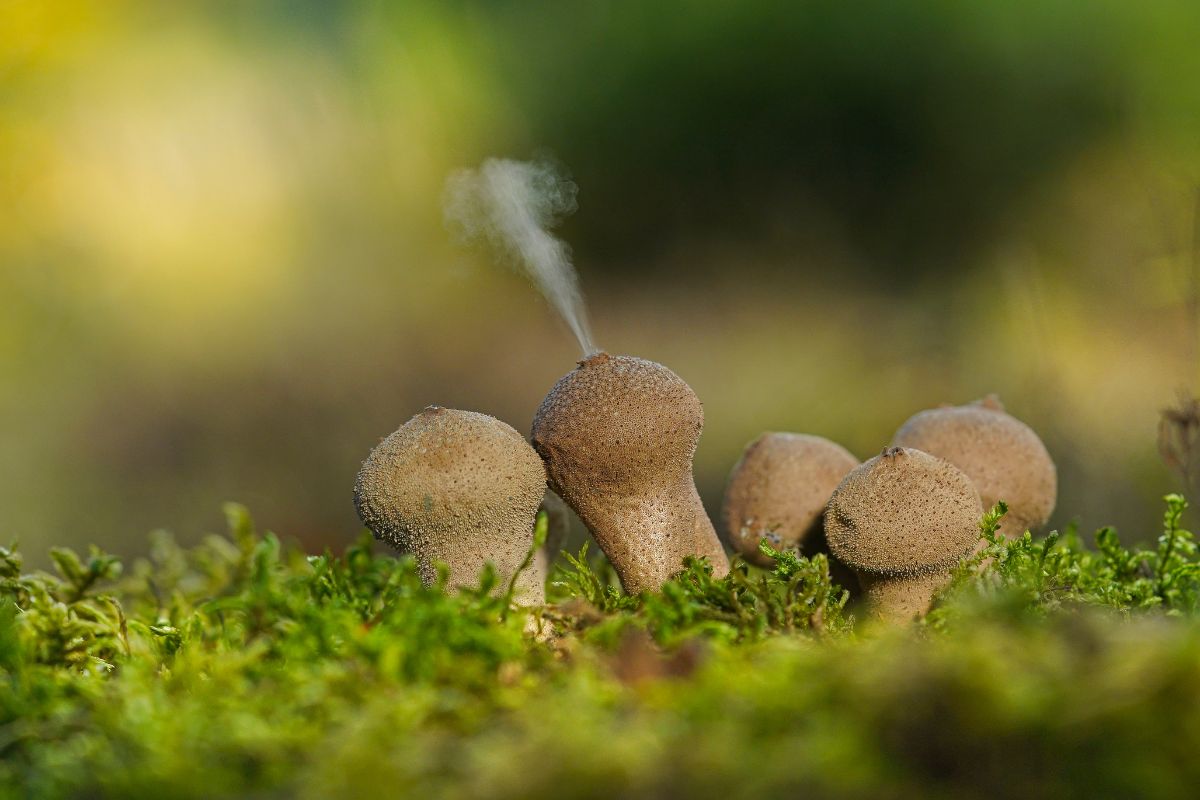
Another potential confusion is with earth star mushrooms, which also grow a wild looking spore case atop a stem of sorts. Earth stars have a similar rounded spore case to the stalked puffball, but their base is completely different. They emerge from a shell and the shell sides arch downwards like legs to push the spore case up. This is quite different from the stalked puffball’s interwoven gelatinous stem strands.

Stalked Puffball Edibility
Most field guides today list Calostoma cinnabarinum and related species inedible. This is primarily due to the consistency and overall appearance — they do not look appetizing!
However, there is a cultural history of edibility with these mushrooms. The Otomi community in Tenango de Doria, Mexico, used to gather young C. cinnabarinum. Their name for this stalked puffball is “yemitas,” they ate them raw. This practice has mostly faded now, and only a few community members remember it. It is remembered as having a mild (not sweet) flavor.
Wild stalked puffballs grow too tough to eat once they mature. They develop underground, and by the time they pop up, their texture is firm, tough, and doesn’t taste good.

Calostoma cinnabarinum by Liz Hunt on Mushroom Observer
Calostoma Medicinal Properties
Traditional healers in Veracruz, Mexico, used stalked puffballs medicinally for generations. They roasted it, ground it into powder, and mixed it with mineral water to help with stomach problems. They mainly used this to treat gastrointestinal disorders. Some Thai communities eat Calostoma species raw for food and also because they are believed to fight microbes.
Research on C. insigne showed antioxidant properties. Tests also revealed the fungi could fight common pathogens like S. aureus and E. coli. Lab tests showed that C. insigne extract can target colon cancer cells in several ways.
Current research points to possible uses in:
- Treating diabetes
- Fighting inflammation
- Boosting immune system
- Protecting nerve cells

Common Questions About Stalked Puffballs
What are the main characteristics of stalked puffballs?
Stalked puffballs, belonging to the genus Calostoma and have a spherical head (spore case) sitting on a thick, gelatinous stalk. They have brightly colored openings on the top of their heads called ostioles that resemble tiny lips. And, they have a unique outer layer that peels away as the mushroom matures.
Where can I find stalked puffballs in North America?
Stalked puffballs are only known from the eastern half of North America, east of the Rocky Mountains. They are most common in the Appalachian Mountains, especially in the southern region, where elevation and moisture create ideal growing conditions.
What is the best time of year to spot stalked puffballs?
While you might occasionally see stalked puffballs in spring, they are most abundant during late summer and fall. Their emergence is often triggered by periods of heavy rainfall, even in typically drier regions.
Are stalked puffballs edible?
Most modern field guides consider stalked puffballs inedible. While some indigenous communities have historically consumed immature specimens raw, mature stalked puffballs are typically too tough for consumption. It’s important to note that their edibility and potential toxicity have yet to be scientifically verified.
Are stalked puffball mushrooms medicinal?
Recent research has shown that some Calostoma species, particularly C. insigne, have significant antioxidant and antimicrobial properties. They also show potential in fighting cancer cells, particularly colon cancer. Traditional medicine in Mexico has used C. cinnabarinum to treat gastrointestinal disorders. However, more comprehensive studies are needed to understand their full potential.









Leave a Reply